Choosing your home exterior material is a BIG deal! Not only is it one of the most expensive line items when building a home, but your exterior is also everyone’s first impression of your home … and I know you want to make a traffic-stopping great first impression! If you are confused about your exterior siding options and pricing … or unsure where to even start in choosing materials for your home exterior, this post is for YOU!
Below is an overview of eight of the most popular types of siding (as well as pros and cons of each) so you can confidently make a decision for your own home build!
WHY EXTERIOR SIDING SELECTION IS IMPORTANT
Exterior siding material is one of the most expensive line items when building a home, so it’s important to understand your options and what fits best with your desired aesthetic (design and curb appeal), local climate (e.g. do you experience extreme temps?), and your budget.
Luckily, there are beautiful options for every budget, climate, and desired aesthetic!
HOW MUCH DOES EXTERIOR SIDING COST?
Pricing is largely dependant on geographical location as well as the quality of product you choose (e.g. the high-end vinyl on my home was possibly more expensive than engineered wood). Honestly, every website I looked at had a different ‘average price per sq ft’, so I have not included actual dollar amounts in this post.
The continuum below (in order from least expensive to most expensive) is *mostly* accurate, BUT it is best to check with a local building professional for the material cost where YOU live and depending on what level of material quality you choose!
Vinyl → Engineered Wood → Fiber Cement → Wood → Brick Veneer → Solid Brick → Stone Veneer → Natural Stone
EXTERIOR SIDING OPTIONS WITH PROS + CONS
VINYL SIDING
OVERVIEW: Vinyl siding is a synthetic material that is VERY popular with homeowners because of its low maintenance, versatility, durability, and low cost (both the product AND installation are lower cost).
Vinyl is available in a wide variety of colors and styles; some products are manufactured to look like natural materials such as cedar shingles (this is what I have on my home).
As with any siding products, there are higher quality and lower quality choices of vinyl; the higher the quality, the higher the cost … and the more ‘real’ it looks (e.g. shake shingle).
Vinyl typically can’t be painted over, so make sure you are pretty confident with your color choice … what you choose is what you get for the long haul!
DURABILITY: Again, this depends on the level of quality you choose. High-end (thicker) vinyl siding is extremely durable! The lower cost (thinner) options can be easily damaged by extreme weather conditions such as high winds and hail … as well as extreme temps. Choose your vinyl type wisely if you live in a climate that experiences extreme temps!
Vinyl isn’t waterproof but it is water resistant; poor installation can lead to water seeping behind it and causing mold.
Vinyl color can fade from sun exposure and it can be difficult to replace just a few pieces without replacing the entire wall of vinyl siding.
MAINTENANCE: VERY low maintenance! It requires an occasional power wash and that’s about it!
VINYL SIDING PROS:
- Inexpensive (material and installation)
- Available in a wide variety of colors and styles
- Higher end (thicker) vinyl is very durable
- VERY low maintenance
VINYL SIDING CONS:
- Unable to paint (most) vinyl siding
- Lower end (thinner) vinyl can be easily damaged by extreme weather (e.g. hail and wind)
- Color can fade from prolonged sun exposure
ENGINEERED WOOD SIDING
Disclaimer: I have no personal experience with engineered wood, so I highly recommend discussing engineered wood siding with your building professional if you are interested in this option!
OVERVIEW: Engineered wood siding is manufactured to resemble wood texture … and it looks very ‘real’! Unlike fiber cement or wood-looking vinyl, engineered wood siding is created from real wood; various wood fibers and strands are combined to create a product that looks like the real deal! It is available in a wide variety of styles.
Engineered wood is considerably less expensive than real wood siding, and installation cost is lower as well because the product is lighter than real wood.
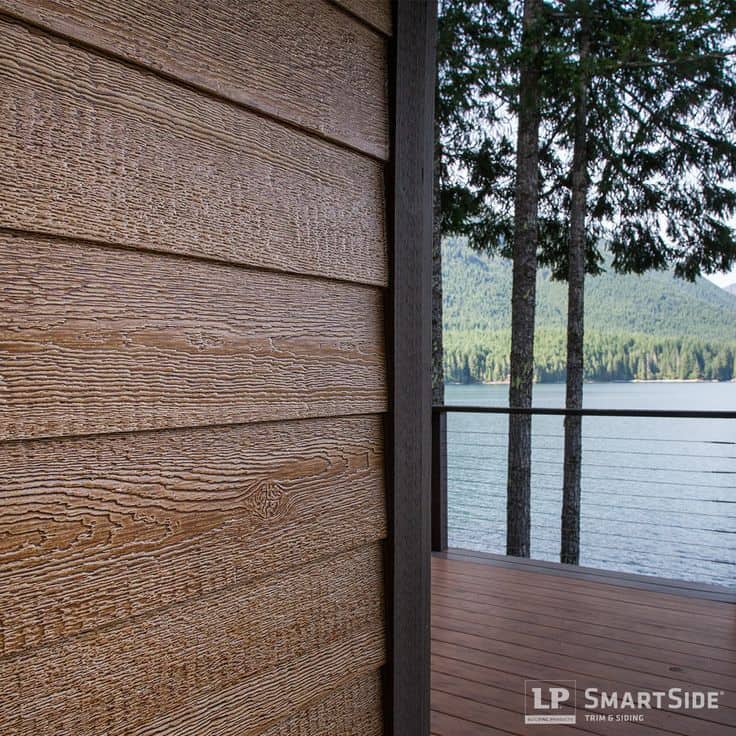
ENGINEERED WOOD SIDING | LP SMART SIDE via BALANCED HOME BALANCED LIFE
DURABILITY: Newer versions of engineered wood are very durable; engineered wood siding holds up well to moisture, fire, insects, and extreme temperatures. Older attempts at manufacturing engineered wood siding weren’t as durable as it is today.
MAINTENANCE: Minimal maintenance (especially compared to real wood)! However, there is conflicting research … some research states that engineered wood siding should be repainted every 5-10 years, whereas others state that it doesn’t need repainted. Again, check with your building professional!
ENGINEERED WOOD PROS:
- Resembles real wood … without the maintenance of real wood
- Less expensive product and installation than real wood
- Made from fibers and strands of real wood
- Much more durable than real wood
ENGINEERED WOOD CONS:
- Conflicting research on the ability to repaint engineered wood siding
- Not the real thing!
FIBER CEMENT SIDING
OVERVIEW: Fiber Cement siding is man-made (James Hardie is a leading manufacturer) from a combination of wood fibers, sand and cement. It is created to mimic the look and feel of natural wood siding … without the maintenance, rot, and insect issues! Sounds like a win to me!
Fiber Cement is an excellent choice if you want the look of natural wood (wood lapboards, cedar shingles, or wood shake), but want something more durable, easier to maintain, and less expensive than real wood.
Fiber Cement is slightly more expensive than engineered wood and is slightly more difficult to install than engineered wood (which = slightly more expensive installation).
Fiber cement can be manufactured in just about any color or design; it can even resemble various textures such as imitation brick or stone. You have the option to purchase it pre-painted OR you can paint (or stain) it after installation. This is what we did with our James Hardie board and batten … we painted it a custom color post installation.
DURABILITY: Fiber cement is extremely durable and doesn’t fade from sun exposure like vinyl does.
MAINTENANCE: Very low maintenance, but does need to be repainted about every 15 years.
FIBER CEMENT PROS:
- Extremely durable
- Resembles real wood texture … without the maintenance
- Available in just about any color or style
- Gorgeous curb appeal (IMO)
- Ability to purchase it pre-painted or can paint it post installation
FIBER CEMENT CONS:
- More expensive than vinyl and engineered wood siding
- Not the real thing!
- Needs to be repainted about every 15 years
WOOD SIDING
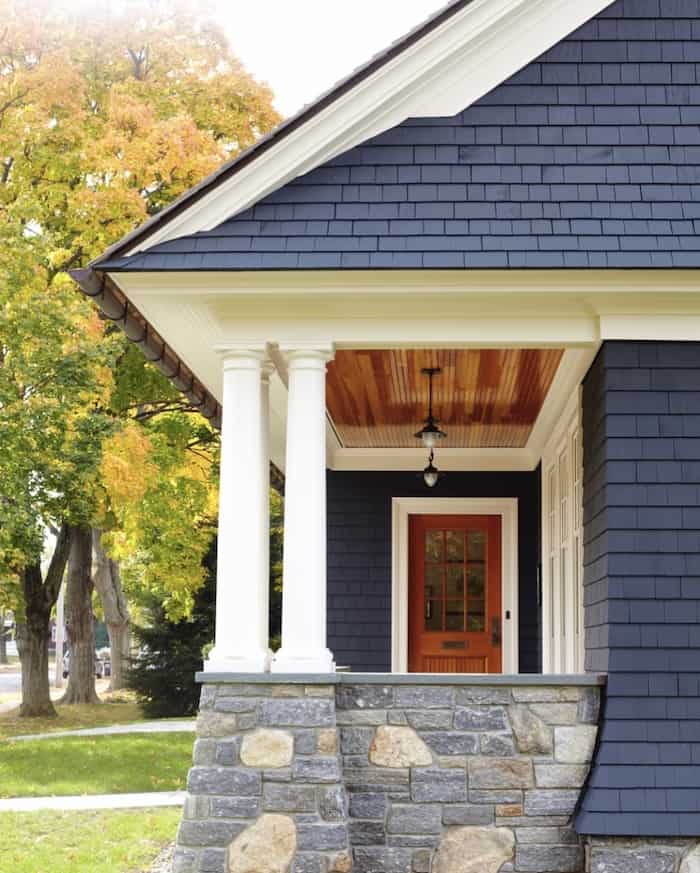
RED CEDAR WOOD SIDING AND NATURAL STONE via DEGRAW & DEHAAN ARCHITECTS LLP
OVERVIEW: Real wood siding is available in many different species and styles (e.g. board and batten, shingles, clapboards, etc.). It is relatively quick and easy to install, and it can be left in its natural state or you can paint or stain it.
Real wood is beautiful, but it is HIGH maintenance … and fairly expensive to maintain!
DURABILITY: The durability level depends on the species of wood. Some species (e.g. redwood and cedar) are more durable than others.
MAINTENANCE: HIGH maintenance! Real wood siding must be stained every 2-3 years or repainted every 4-5 years. It is not fire resistant and it is prone to damage from termites, woodpeckers, and rot.
WOOD PROS:
- Natural and beautiful
- Available in a wide variety of species and styles
- Relatively quick, easy, and inexpensive to install
- You have a choice to leave in its natural state or paint/stain it
WOOD CONS:
- HIGH maintenance … and expensive to maintain
- Must be stained every 2-3 years or repainted every 4-5 years
- Prone to damage from termites, woodpeckers, and rot
BRICK VENEER SIDING
OVERVIEW: Brick veneer is a thin layer of brick anchored to a wood frame. It is less expensive than solid brick, more durable, and provides better insulation. It is applied more like siding. Brick veneer is more affordable than solid brick, BUT still quite expensive!
DURABILITY: Highly durable; provides better insulation than solid brick. It doesn’t fade or rot like some of the other exterior siding options. Moisture retention can cause issues in climates with high rainfall.
MAINTENANCE: Minimal maintenance.

BRICK VENEER WALL | CHRISTINA’S ADVENTURES
BRICK VENEER PROS:
- Less expensive than solid brick and easier to install (= less labor cost)
- Provides better insulation than solid brick
- Highly durable
- Doesn’t fade or rot
- Minimal maintenance
BRICK VENEER CONS:
- Lower cost than brick but still expensive compared to other siding options
- Not the real thing!
- Prone to moisture issues
SOLID BRICK
OVERVIEW: I think we all are familiar with solid brick! It’s extremely durable and will last forever! It is also VERY expensive both for the brick product and installation.
DURABILITY: Brick is incredibly durable and fire resistant. It doesn’t fade, decay, mold or rot; however it is not very water resistant and does not provide the best insulation.
MAINTENANCE: Very minimal maintenance; it never needs to be refinished (unless you paint it as shown below) and can easily last 100+ years!
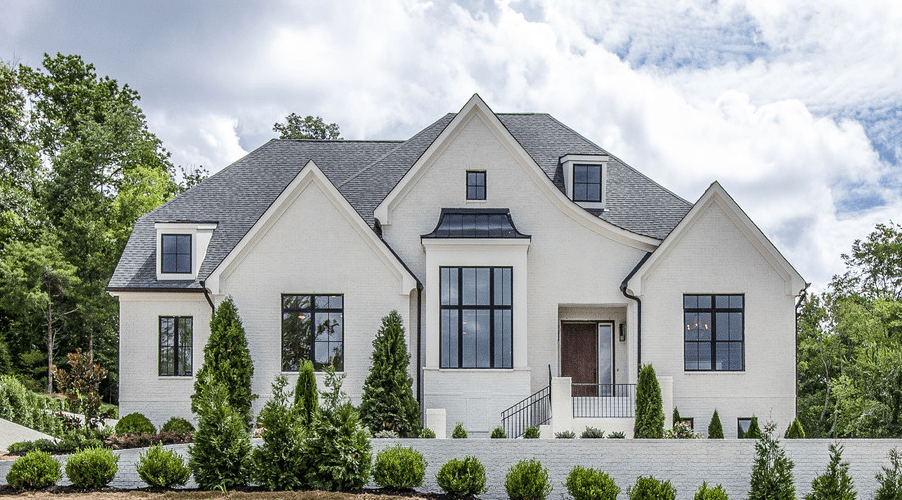
PAINTED WHITE BRICK EXTERIOR | TENNESSEE VALLEY HOMES
SOLID BRICK PROS:
- Extremely durable
- Very minimal maintenance; never needs to be refinished (unless painted) and can last 100+ years
- Fire resistant
- Weathers beautifully … will not fade, decay, rot or mold
SOLID BRICK CONS:
- Not very water resistant and not very good at insulation
- Cost of material and installation are high because of the labor-intensive process to install
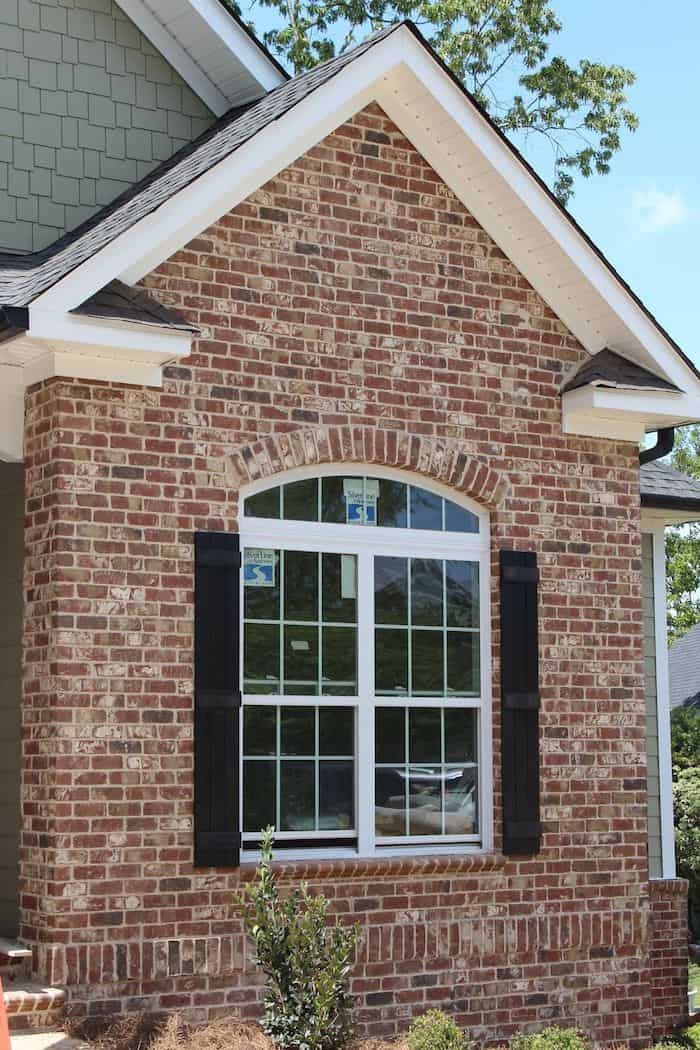
TRADITIONAL BRICK | DECOR TIP
STONE VENEER SIDING
OVERVIEW: Stone veneer is manufactured to look almost exactly like stone for a fraction of the cost of product and installation (but still WAY more expensive than many other siding options!). Proper installation of stone veneer is CRUCIAL to ensure that it withstands weather, time, and humidity! Do your research on installers!
DURABILITY: Highly durable BUT doesn’t respond well to excessive moisture or extreme temperatures (especially if not properly installed). It will NOT last as long as natural stone.
MAINTENANCE: Low maintenance; can hose it down if needed.
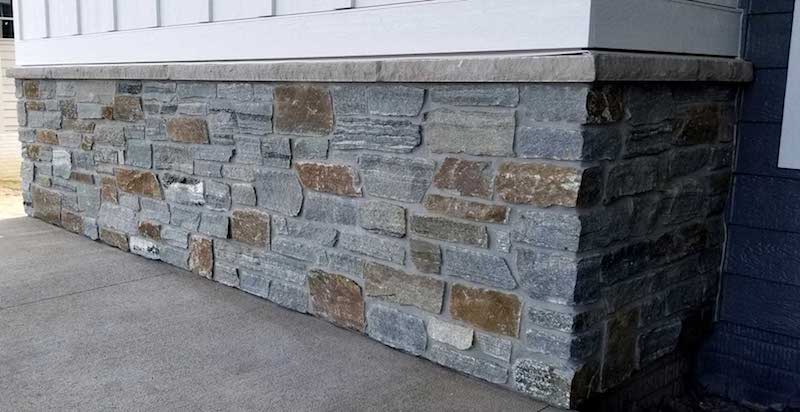
STONE VENEER SIDING | BUECHEL STONE
STONE VENEER PROS:
- Looks very much like natural stone
- Less expensive to purchase and install than natural stone
- Low maintenance
STONE VENEER CONS:
- Less expensive than natural stone, but still VERY expensive compared to other siding options
- Will not last as long as natural stone
- Does not do well with extreme temps and excessive moisture
- Proper installation is CRITICAL!
- Not the real thing!
NATURAL STONE
OVERVIEW: I don’t think natural stone needs much of an introduction! It is the most expensive of all siding options (both material and installation), but it is GORGEOUS!
DURABILITY: EXTREMELY durable! Extreme weather does not affect natural stone, so it will last a lifetime! Stone is also resistant to moisture, fire, and insects.
MAINTENANCE: Natural stone must be sealed properly, but other than that is requires very minimal maintenance.
NATURAL STONE PROS:
- Natural product
- Extremely durable
- Weather, fire, and insect resistant
- Minimal maintenance
- Will last a lifetime
- STUNNING (IMO)!
NATURAL STONE CONS:
- VERY expensive (both product and installation)
- Requires proper sealing
CONCLUSION
Ok, that was a lengthy overview of eight of the most popular exterior siding options! I truly hope you feel like you now have a better understanding of your options … as well as the pros and cons of each one!
You can find many more helpful home-building blog posts HERE, and make sure to grab my FREE guided worksheet ‘How to Make Design Decisions for your New Home Build’!
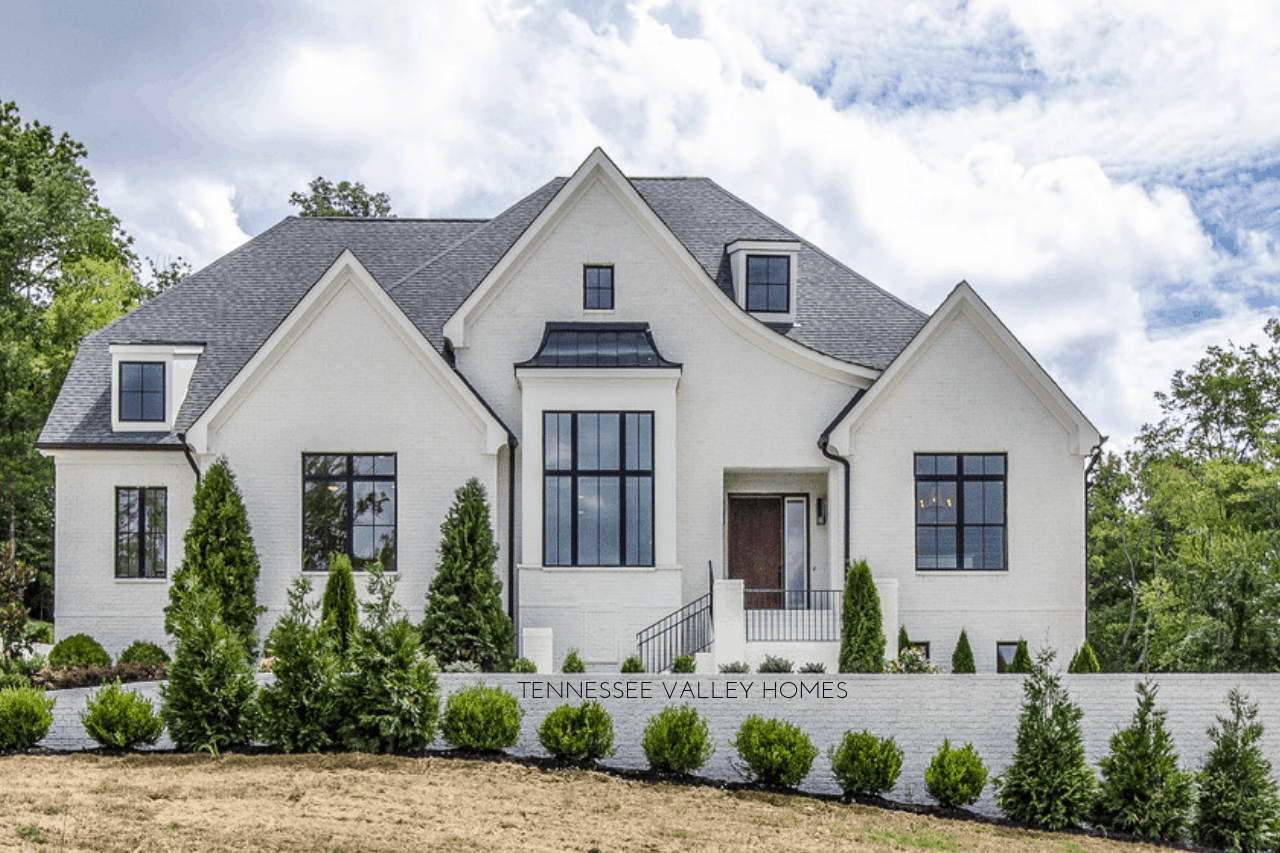
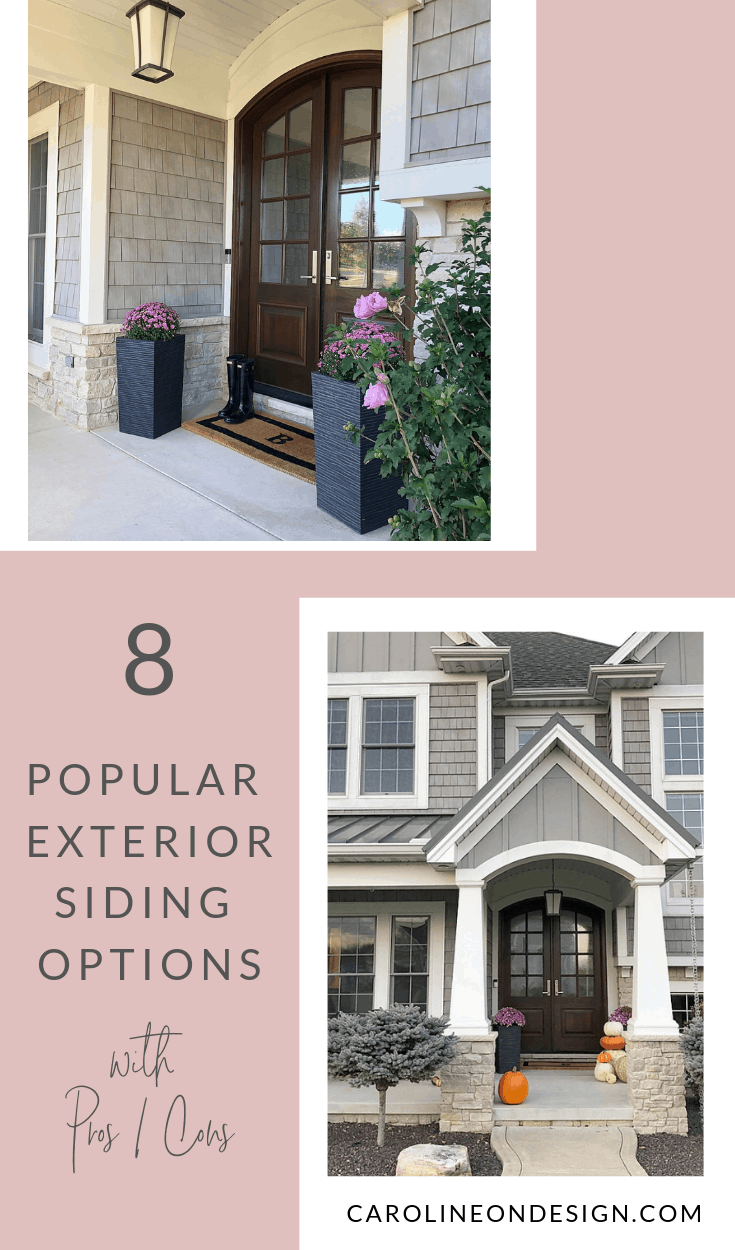

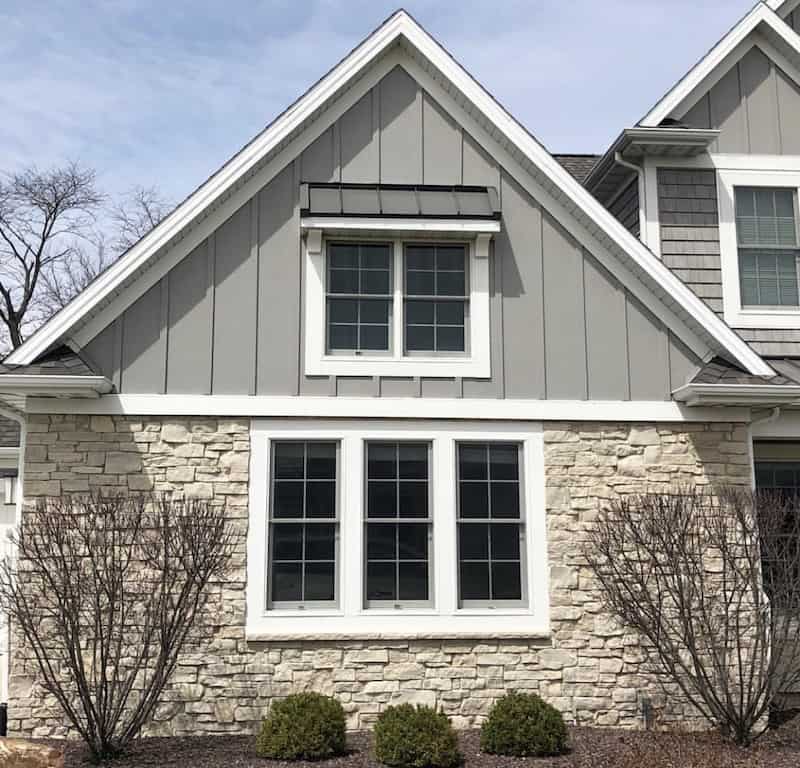
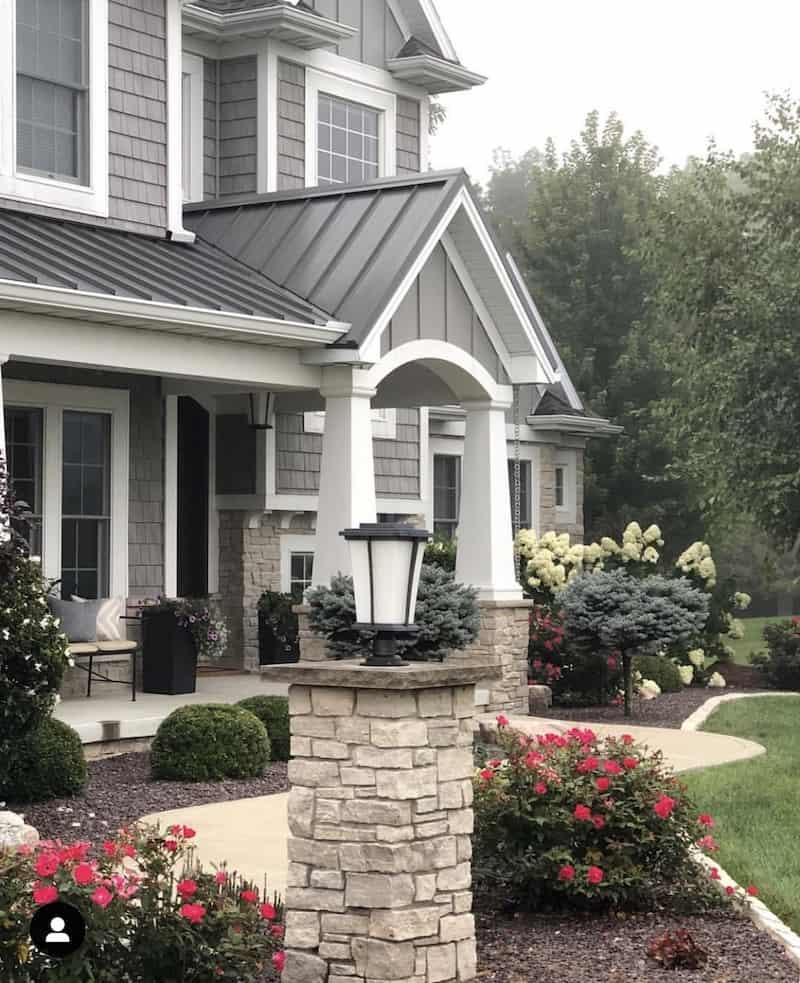
That’s cool that vinyl siding is cheaper for both the product and the installation. I would definitely want to save as much money as possible o a new house so maybe some vinyl siding would help reduce costs. I have been thinking about building a new house since my family is growing out of the old one. I’ll have to remember that vinyl siding is a good option when I look at the options I have for a house.
Oh yes … it’s always good to find ways to SAVE when building a house! Just remember that not all vinyl is created equal! Vinyl that is very low cost will obviously not be the greatest quality. You can find mid- to high-quality vinyl products that will last and are still well priced as compared to other exterior materials!
Where did you get the white trim on your arched board and batten gable? Is it custom made or is it an option when using fiber cement? I have been looking at vinyl board and batton nit fir an arch they don’t have any trim options.
Hi Emily!That is a really good question … and I am not 100% sure of the answer. Our board and batten is all fiber cement, so I assume the arched white trim is a custom cut fiber cement board as well. Sorry that I don’t have a definitive answer for you!
I liked that you said that one thing to consider when you are having vinyl siding installed on your home is the quality in order to ensure durability. I would imagine that you are correct in saying that high-end vinyl siding is extremely durable and will be sure to last a long time. I would be sure to consider hiring a professional to install high-end vinyl siding on my home in order to protect my home and family from extreme weather for a very long time.
My cousin bought a house, but the siding is not in great shape. He asked me for help to find witch siding fits best for his house. Thanks for suggesting that fiber cement siding lasts longer and it is easier to maintain.
I’m so glad you found this post helpful, Eli! Good luck to your cousin!
Would love to know about the products in your post picture. Brand? Color? Shaker and broad and bat look great. What color and manufacturer is the metal roofing from? Searching for our new home build!
You can find my exterior sources HERE. I don’t have the information on my metal roof … but the other info is all on my exterior sources page :).
Thank you for this well informed post on siding options. I have searched without much luck for this type of post and came upon this while researching white exteriors. I am grateful for your knowledge and well researched post. I think i will go with a high quality vinyl shaker style in white for my sweet cape cod. And a dark stained wood style door and charcoal green shutters! Timeless i hope!
Oh my goodness … your house sounds like it’s going to be GORGEOUS! I love my Mastic brand vinyl shake siding! Good luck and send me a pic of your exterior when it’s completed! – Carrie
You’ve got some nice content and pictures here. I think you’ve done a good job with your suggestions. As someone who is looking to get new siding I found this article extremely helpful in which type of siding I should look for.
https://conservationconstructionofdallas.com/siding/
Can you tell me the color on your shakes and hardy board as well as the metal roof color?
Please see my exterior sources page for all exterior info (although I don’t have the name of my metal roof color).
Hello! I came across your site and really love your suggestions. We are looking to replace our cedar siding next year. Are you able to use natural stone/veneer when replacing? Or only during the build? Appreciate any tips. I’m signing up for the newsletter! Thank you!
Hi Nina! That is a good question to ask a professional installer. I can’t give you an answer because I don’t want to steer you in the wrong direction!
Thank you for the work I know it took to put this article on siding pros and cons together! I came to read about vinyl siding but was drawn to the entire article. I love the last photo, the gray house with natural stone, and just re-read the caption, it’s your house! It’s stunning! Thank you for sharing it.
Looking at some of the comments below, there are many top-quality vinyl sidings made in the USA!
Thank you so much, Trish!
Can you share some higher end name brands of vinyl? I’m hoping to build and have to stay at the lower end, but want to make sure it’s better, thicker made than what I have on my current home. Thanks!
I’m not an expert in vinyl siding, so I would talk to a local retailer who supplies vinyl siding. They can give you much better info than I can :).
We are in the “just put stakes in” stage of our lake house – final home!! (living in a condo in the meantime). My hubby wants minimal maintenance. If we put stone below the waterline (kind of like you did) and brick above – is that ok? It seems like I read somewhere that you don’t put stone and brick together. There are really light bricks as opposed to painting?
Thanks! This is a really hard choice and without being able to actually see a house makes it really intimidating as, like you said, it’s the first thing people see. We have driven through so many neighborhoods looking at exteriors!!
Appreciate this site!
Yes, Jenny! Choosing the exterior can be very intimidating. There are some beautiful homes that have a mixture of brick and stone. I recommend that you search on Pinterest (or keep driving around neighborhoods) to find a brick/stone combo that you love. I think there needs to be a little contrast between the stone and brick color. We have a house in our neighborhood that has a stone/brick combo that almost blends together … I am not a fan of that house 😫. Just make sure to have a little contrast in color.
Thank you for this very informative article. We purchased our house 20 years ago. The style was listed as “architectural “ which means “it’s a mixture of so many styles, they couldn’t label it. We are finally ready to add some real curb appeal! Do you know of any easy to use software that I can purchase to draft different variations of exteriors from shingles to vertical siding or just paint options to my stucco home? I have found siding sites but they aren’t easy to maneuver around.
Thank you.
Hi Lynne! That’s a great question, but I don’t know of any software options to recommend to you. I would do a Google search and I’m sure you’ll find many options. Best of luck! Carrie
It’s interesting to know that vinyl siding installation is a cheap but durable option for home improvement. I can see how this can easily help in making my house look attractive to potential buyers in the future. I better start thinking about what design to choose in order for my home to stand out in my neighborhood.
Hey, I didn’t see anything about steel siding. I’ve gotten 6 estimates and think that is the one. Its about the cost of fiber cement siding. Comes in loads of colors that look like wood. And fire & water resistant. Board and batten with shingles in the peaks 4 tone grey and natural wood colors
Hi KC … steel siding sounds like a good option too. Thanks for sharing your experience with steel siding … I’m sure that will help other readers!
Really like the pictures in this article along with the information. Good comparisons!
http://www.abingtonmasonrycontractor.com
Do you happen to know the Brand & Color of the brick in your photo?
I don’t have the product info for any homes other than my own. You’ll have to contact the original source of the image you are referring to. All sources are included in this blog post. Best!
I’m glad that I found this article. This is a very useful and informative article which will help me in my research of exterior siding options. As a student, I am always looking for the best possible material to use as well as the most efficient ways to use it and this article gives me some tips about these issues.
Also, Don’t forget to check out this website – https://barndominiumideas.com/
This is such a helpful guide for anyone considering exterior siding options! I appreciate how you broke down the pros and cons of each material, especially in terms of durability, maintenance, and cost. Your insights into fiber cement and engineered wood are particularly interesting—it’s great to see how these newer materials are balancing aesthetics with long-term performance.
I’m curious, when comparing these siding options, how do regional factors like humidity or extreme temperatures affect their longevity? For example, would vinyl or fiber cement hold up better in more humid climates? I’d love to hear your perspective on this!